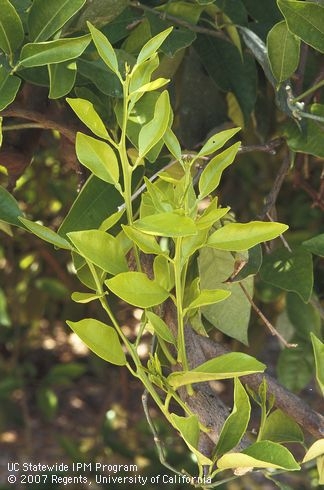
Yellowing Citrus Leaves
Leslie E. Stevens UCCE Master Gardener
Bright green leaves sheltering colorful hanging fruit distinguish healthy citrus trees. Yellow leaves, on the other hand, spell trouble.
Causes are numerous, but often relate to improper irrigation and nutrient deficiencies. Other culprits include pests, bacteria, fungi and phytotoxicity caused by a variety of herbicides, fungicides and salt burn.
Water: As evergreens, citrus may require irrigation year-round to ensure good soil moisture to a depth of about 2 feet for mature trees. Conditions that are too wet or too dry can reduce the tree's ability to take up nutrients, especially nitrogen. Very dry root zones, an impact of the ongoing drought, have led to more nitrogen deficiencies seen in citrus. At the same time, it's important to ensure good drainage, since water-logged roots cannot adequately absorb soil nutrients. If you see a tree canopy of pale green-to-yellow leaves, check your soil moisture in the top two feet before applying fertilizers.
Allow the top 6 inches of soil to dry between watering, typically ranging from 7-to-14 days depending on weather and soil conditions. For this reason, citrus trees should not be planted in lawns or near heavily irrigated plants. Also ensure you have good soil moisture on the deep end of the rootzone so that roots can take up available nutrients.
Fertilizer: Citrus trees require regular doses of nitrogen, zinc, manganese, magnesium and iron to remain healthy and productive. Two or three applications of a slow-release citrus formula annually should do the trick. If you only manage a single dose per year, apply in early spring prior to flowering and fruit setting when nutrient demand is highest.
Mulches: A nutrient-rich mulch of yard waste consisting of wood chips, grass clippings and leaves can also be beneficial for citrus trees, according to the University of California. The high nitrogen in grass clippings offsets the high carbon of the wood chips, and the combination has been shown to be effective in suppressing Phytophthora root rot when present in the soil.
Also be sure to keep mulches at least 6 inches from tree trunks to discourage fungi and bacterial growth on trunk and roots.
Resources: Visit UC- IPM Website for colored pictures and detailed descriptions of common diseases and deficiencies negatively affecting citrus trees.
http://www.ipm.ucdavis.edu/PMG/C107/m107bpleaftwigdis.html